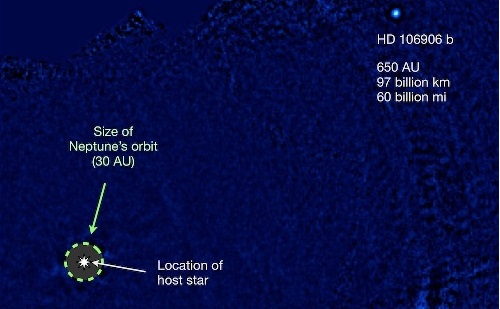
HD 106906 b, a directly imaged planet announced in 2013
First, foremost, and perhaps most painfully: α Centauri Bb may not really exist. What we thought was the Keplerian signal of an Earth-mass planet at our nearest neighbouring system may actually be noise in the data. While a bit painful, this is how science works – claims are rigorously tested and beaten tirelessly until they either continue to stand on the merit of the evidence, or they are refuted and disproved. This is how we keep the muck out of our pool of knowledge. Stay tuned… this could take a while to fully resolve.
The year began with direct imaging news: A new HST detection of Fomalhaut b (see here), suggesting the “planet” orbit is either not coplanar with the system disk or crosses the ring orbit and has a much lower mass than initially suspected. The imaged planet around β Pic b has also been independently confirmed. A circumbinary planet at 2MASS J01033563-5515561 became the first to be directly imaged. A planet with a mass of ~4 MJ became the lowest-mass planet directly imaged at HD 95086 (with the caveat that it isn’t clear what the nature of Fomalhaut b is). A planet perhaps of similar mass was later reported at GJ 504 (59 Vir).
Habitable zone discoveries started with the first known transiting Jupiter-sized planet in the habitable zone, PH2 b. Then things got very interesting with the simultaneous announcements of a super-Earth straddling the inner edge of the habitable zone of Kepler-69, and two habitable planet candidates at Kepler-62, which was covered here. HARPS found a nice system of planets around the M dwarf GJ 163. One of the planets is somewhat near the habitable zone, but it is my position that this planet does not deserve the attention worthy of a habitable planet candidate, with the planet receiving 40% more irradiation than Earth, and with the host star being an M-type dwarf, the atmosphere will not provide as much scattering of irradiation as Earth’s (Rayleigh scattering is increasingly efficient with decreasing wavelength), causing the surface of the planet to actually receive more than 40% more irradiation than Earth. Despite this, HARPS did provide us with another potentially exciting habitability result, with no less than three super-Earths in the habitable zone of GJ 667 C, with evidence for at least six, perhaps seven total planets there, however a reanalysis of the RV data seems to suggest that these new planets do not exist. Stay tuned…
Other noteworthy announcements included DW Lyn b, a giant planet orbiting a pulsating subdwarf B-type star. A hot Jupiter was also found orbiting a late-K/early-M dwarf by SuperWASP – a particularly rare find. A pair of super-Earths were found in a 2:3 resonance at HD 41248. A giant planet was found in a close orbit around a red giant branch star. Evidence of a second planet accompanying a newly discovered debris disk was presented for κ CrB. A super-Earth around HD 97658 was reported to be transiting (as was suspected two years ago but later dismissed due to a non-detection). The pair of planets at HIP 11952 ended up not existing – an error in compensating for the radial velocity of the observing site relative to the star.
Kepler results continued to stream in, starting with a rather interesting three-planet system at Kepler-68, with a mini-Neptune closest to the star, then an Earth-sized planet just outward of that, and a Jovian planet in a long-period orbit. It was shown that systems of multiple, low-mass planets uncovered by Kepler, like our own solar system, have orbits that are well-aligned with their host star’s equator (see here and here). Kepler results also uncovered a system with a pair of planets in a 2:1 resonance producing very strong transit timing and transit duration variations. A hot Jupiter at Kepler-76 provided strong evidence of super-rotation in the atmosphere via its secondary eclipse visible light photometry. Of particular note is the announcement of a planet smaller than Ganymede(!) at Kepler-37. A new population of small, rocky worlds in extremely short orbits was uncovered by Kepler, specifically Kepler-78 b wih its 8.5 hour orbit and KOI-1843.03 with its 4.2 hour orbit(!). Furthermore, Kepler unveiled the first transiting planets in an open cluster, NGC 6811.
Of particular note is the discovery of a transiting hot Jupiter orbiting a young, oblate, gravity-darkened T Tauri star. This remarkable system seems to imply that the formation mechanism behind hot Jupiters is fairly fast.
Exoplanet catalogues for WASP and Kepler saw their first triple digit identifiers, with WASP reaching WASP-100 and several Kepler planets being assigned triple digit Kepler-ID’s as well (e.g., Kepler-114, Kepler-128, Kepler-177, …).
While Kepler suffered another reaction wheel failure, effectively ending its primary mission, the year ended on a positive note with the launch of Gaia, which will likely find as many planets as Kepler, but in more intermediate period orbits and closer to the solar system.